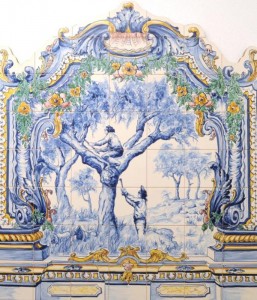Oh dear … a lot of text … in a time that we don’t take time to really read. But we can’t help it: Cork is too special to be fobbed off with a few pictures. If you really want to know something about this special piece of nature, take your time for old school reading. Cork itself has also taken a lot of time to become a remarkable raw material. We promise to do our best to keep this page as short as possible (and we won’t quiz you).
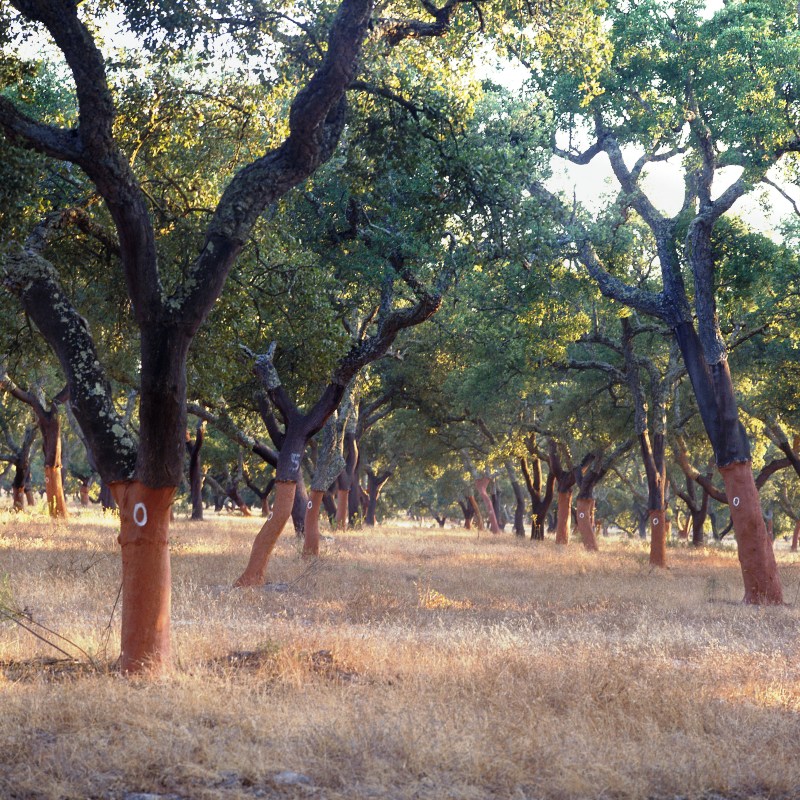
Cork..
..is the bark of thee cork oak (Querqus Suber). It is a whimsical tree that tends to grow crooked, 10 to 20 meters high and can live 150 up to 200 years. The tree crown is very light and open and consists of branches with long, oval-shaped, acuminate, often serrated, leathery grey-green leaves. It grows best on granitic soils without limestone, such as those found in Portugal, Spain, southern France, Italy and the Maghreb. Oh well.. in short: around the Mediterranean Sea.
Due to cell rejection of the mother bark (cambium / thin membrane that is located on the wood of the trunk), an ever thicker vegetable layer grows that is made up of dead, locked against each other 14 plane micro-cells (kind of honeycomb) that consist of cell walls of suberin (hence Quercus Suber) which are interconnected by lignin. These non-uniformly built cells (40 million cells per cubic centimeter) are filled with a gas mixture that resembles air, but without CO2 and allows virtually no water or air to pass through. The continuous cell formation provides an insulating layer against the high summer heat. Without this protection, the tree would dry out (The light crown of the tree does not provide enough shade to protect the tree from drying out). In addition, the bark also protects the tree from other external influences. Even in the event of a fire, the bark protects the trunk, so that at a later stage the tree can still form branches and leaves again.
“Corking” of a tree bark or of a plant stem is a phenomenon known to biologists. There are more trees where the grown dead cells form a protective bark, but only the bark of the cork oak can be used technically and commercially.
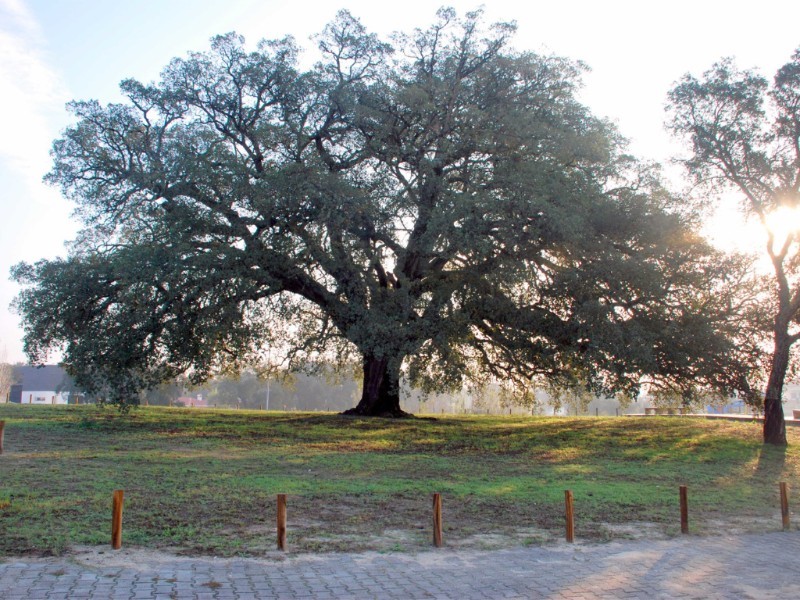
The largest cork oak tree in the world..
..is named “Whistler” due to the sound made by countless birds living in it.
It was planted in 1783 in the district of Setúbal (Portugal), and it bark has been harvested over twenty times since then.
In addition to the contribution to the cork industry, it has great significance for the ecosystem and the fight against climate change. The “Whistler” has been classified as a “tree of public interest” since 1988 and is listed in the Guinness Book of Records as the largest cork oak tree in the world.
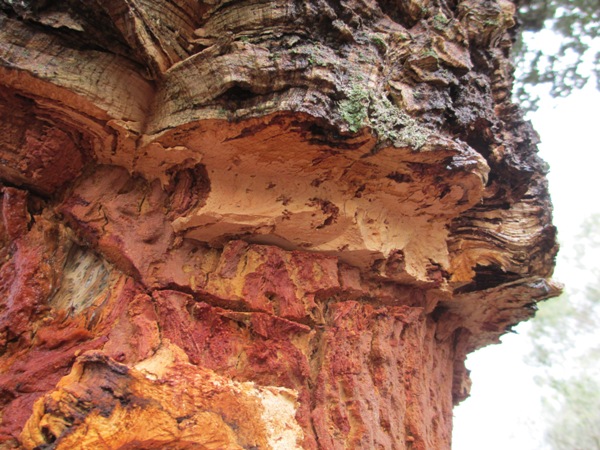
In the thick bark layer..
..the billions of cells each function as small sound and heat insulators, absorb pressure and shock and give cork buoyancy and its enormous resilience (due to its elasticity, a (wine) cork can be pressed together up to 35% of its original diameter).
By constantly taking on its original shape, cork (a cork floor) can withstand heavy loads. To this date no other natural material has been found that combines these different properties like cork, and probably never will be.
Harvesting..
..is only possible from the moment the tree is mature. Although the first cork formation starts after about 4 years, the first bark is harvested at an age of 25 years with a minimum trunk circumferenceof about 70 cm. From this point the bark of the tree will be harvested every 9 years (regulated by law), until the tree is about 200 years old. Then it is replaced by a new one,
Professionals..
..peel the bark of the tree in May and June, just before the hottest months of the year, when the cork bark detaches from the mother bark due to moisture extraction. The tree goes into ‘summer sleep’, liquids and juices would only evaporate through the leaves. The trunk shrinks slightly so the bark (which does not shrink proportionally quickly) is just a bit looser and easier to harvest. It is a government-regulated, highly specialized work where only the outer bark layer is harvested. The continuously growing mother bark is not harvested.
This traditional harvest has been around for hundreds of years and is a completely manual process. The tools used for this are special axes and manpower. Peeling requires a great deal of expertise as the cut must be made deep enough to peel the cork layer up to 5cm thick from the tree but not too deep, otherwise the thin mother bark would be damaged too much. After debarking, the tree secretes a reddish colored moisture (by air oxidation) (phloem juices) to protect the mother bark, which dries to a very hard layer, a few millimeters thick. With its reserves, the wound will heal within three months and growth can continue normally. The newly formed cells are already visible again in the autumn of the harvest year.

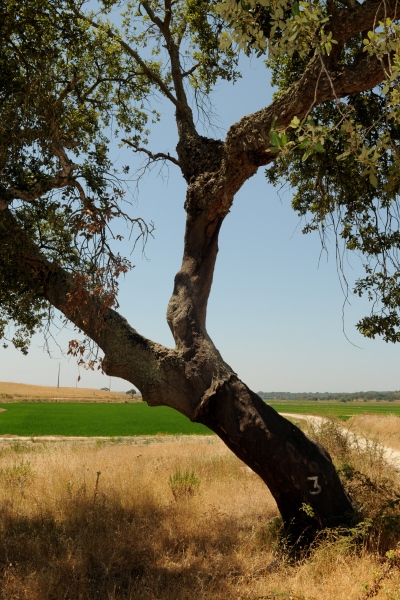
The tree..
..will isolate itself again and in that process it absorbs more CO2 than if it had not been peeled. Because they know in advance which and when trees can be harvested, it is fairly easy for manufacturers to predict in which year the harvest will have a large volume or a lesser volume. And that for several consecutive years in a row.
A cork oak can be peeled about 20 times in its life before it is no longer able to produce good quality corkwood due to its advanced age and makes way for a new sapling, which is also needed for the typical bark of the first harvest. The best quality cork bark is produced when the tree is about 70 years old. The number painted on the tree is the last digit of the year in which the tree was last peeled.
One can recognize the growth process of the different years by the thickness of the bark layer with its annual rings: 8 complete rings and a half annual ring on each side (the trees are harvested in the middle of the growth process of 1 annual ring). Climatic conditions, such as amount of rain or the length of a summer period, influence the thickness of the growth rings. The quality of the peeling (workers skills) also has an impact on the thickness of the annual rings.
Harvesting..
..the bark has no adverse effects on the tree. In fact, peeling the tree encourages the growth of new bark of a better quality with a smoother and more homogeneous structure.
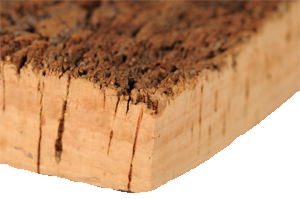
Lenticels (brown grooves and holes) contain a woody brown powder (tannin).
The first harvest..
..from a young tree yields virgincork. Since each tree produces virgincork only once, the availability is limited. This bark is hard, somewhat silvery in color and has a very irregularly shaped cell structure.
The cortex is structured in such a way that only a few functions can be given to it:
- Decorative in pure form: Often found in terrariums, as a breeding ground for orchids or in Christmas decorations.
- Decorative in rough form: 3D bark plates
- Decorative in veneer blocks: as in the cork types Rio Grande and Vitoria
- As granulate: as raw material for insulation rolls or Acoustic
During the removal of this first layer of bark, slit-shaped injuries are made along the length of the trunk at the same time. The purpose of this is to obtain a homogeneous structure of the new bark. It simplifies subsequent debarking while also obtaining nice large pieces. Cracks form on the injuries that facilitate the breathing of the tree. As a result, fewer woody lenticels (respiratory cells) are formed between the cork cells.
The second harvest..
..is the so-called female cork (callus layer). There isn’t much to say about it. The quality of the second harvest is not yet good enough to make wine corks. But it is unique, which means that certain veneer decors (such as cork type Merida II) can be made from it. Otherwise, it is granulated into raw material for industrial cork or insulating cork (rolls and plates).

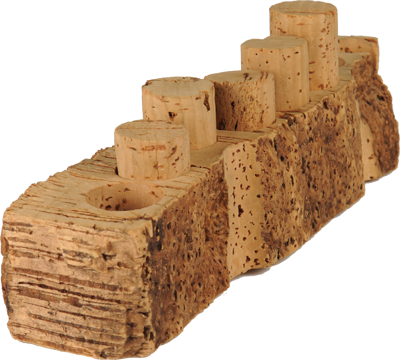
Only the third harvest..
..(and all subsequent harvests) yields cork which is resilient and regular in structure. The first 2 harvests certainly have their uses in the industry, but it takes a solid 45 to 50 years before a newly planted tree produces cork bark that can be processed into the main uses of the bark and used for higher quality applications.
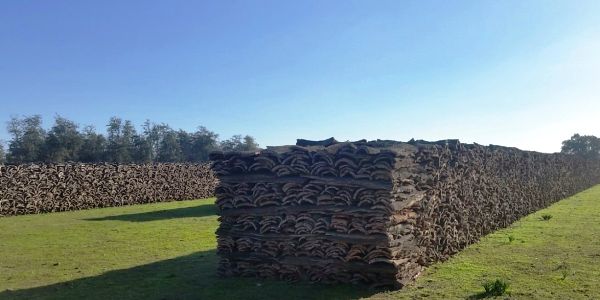
The many thousands..
..pieces of bark (cork coats) should normally remain in the forest for another 3 to 6 months to allow the natural moisture in the bark to evaporate after which the bark is driven to the cork factories. In these factories the bark is given plenty of time to dry and thus lose tension and shrinkage, or at least it should. It can sometimes take up to two years before a piece of bark is processed into a finished product, depending on the amount harvested. But due to the growth in demand, we see the industry processing the bark much quicker.
Before the bark can be processed, it is first boiled to kill all insects and bacteria and to make the bark more flexible. Boiling cork is a challenge in itself because of its huge buoyancy, so it takes a lot of weight to get the cork bark pieces under the water. Without losing its properties, the cork cells are enlarged (swell) during the cooking process and they release tannic acid and inorganic salts. The rubbery cork boards are then stacked in dark sheds for 3 to 4 weeks to dry and flatten.
After the bark has dried, the plates can be sorted according to quality, with inspectors paying attention to thickness, elasticity, homogeneity and colour. The bark can now be processed into a product. All things considered, the processing industry has, to look at it in a black and white manner, only the 3 basic raw materials: the first harvest, the second harvest and everything that comes after. But that can be used in an impressive variety of product. Many examples of this can be found on this site.
